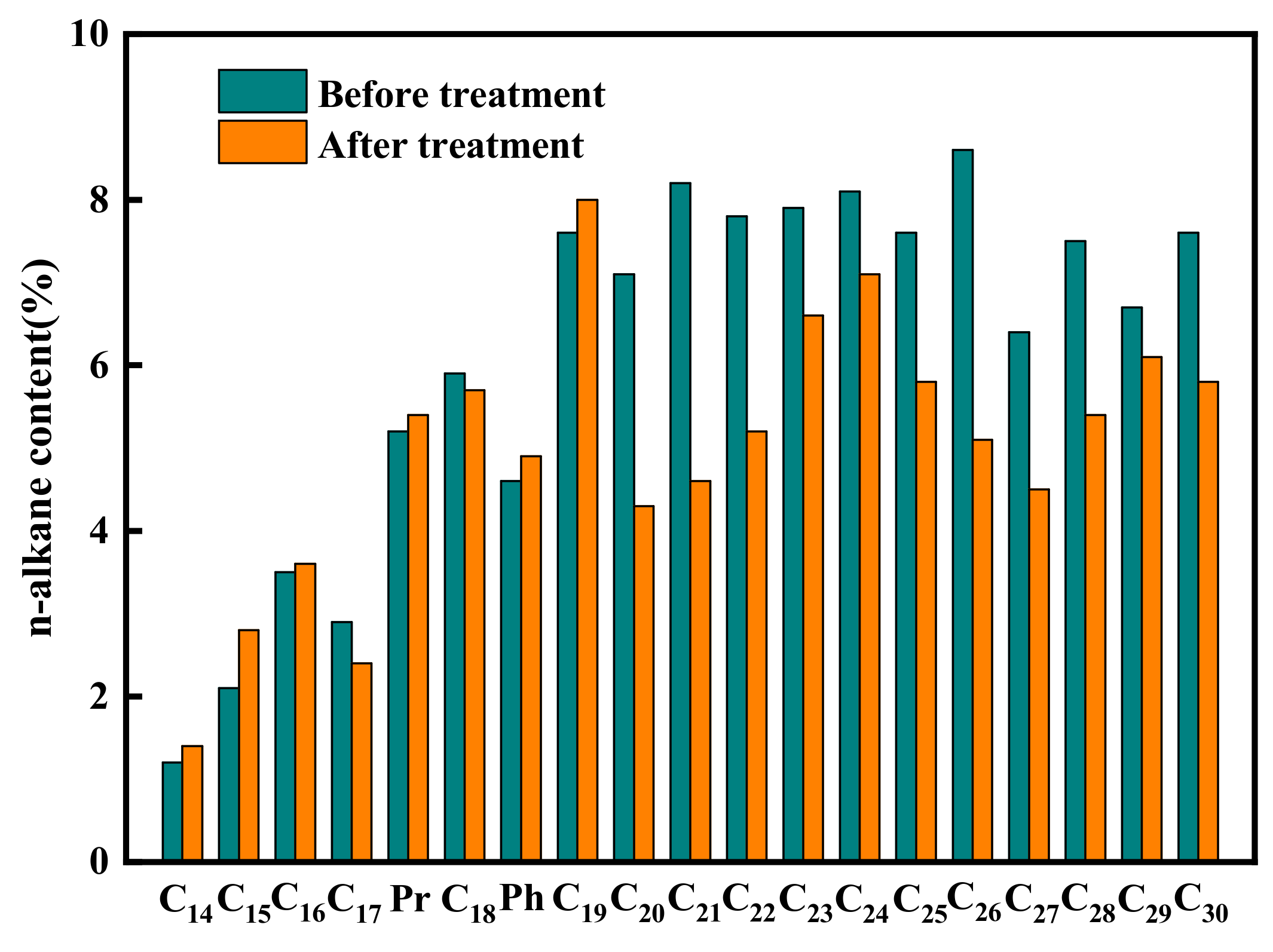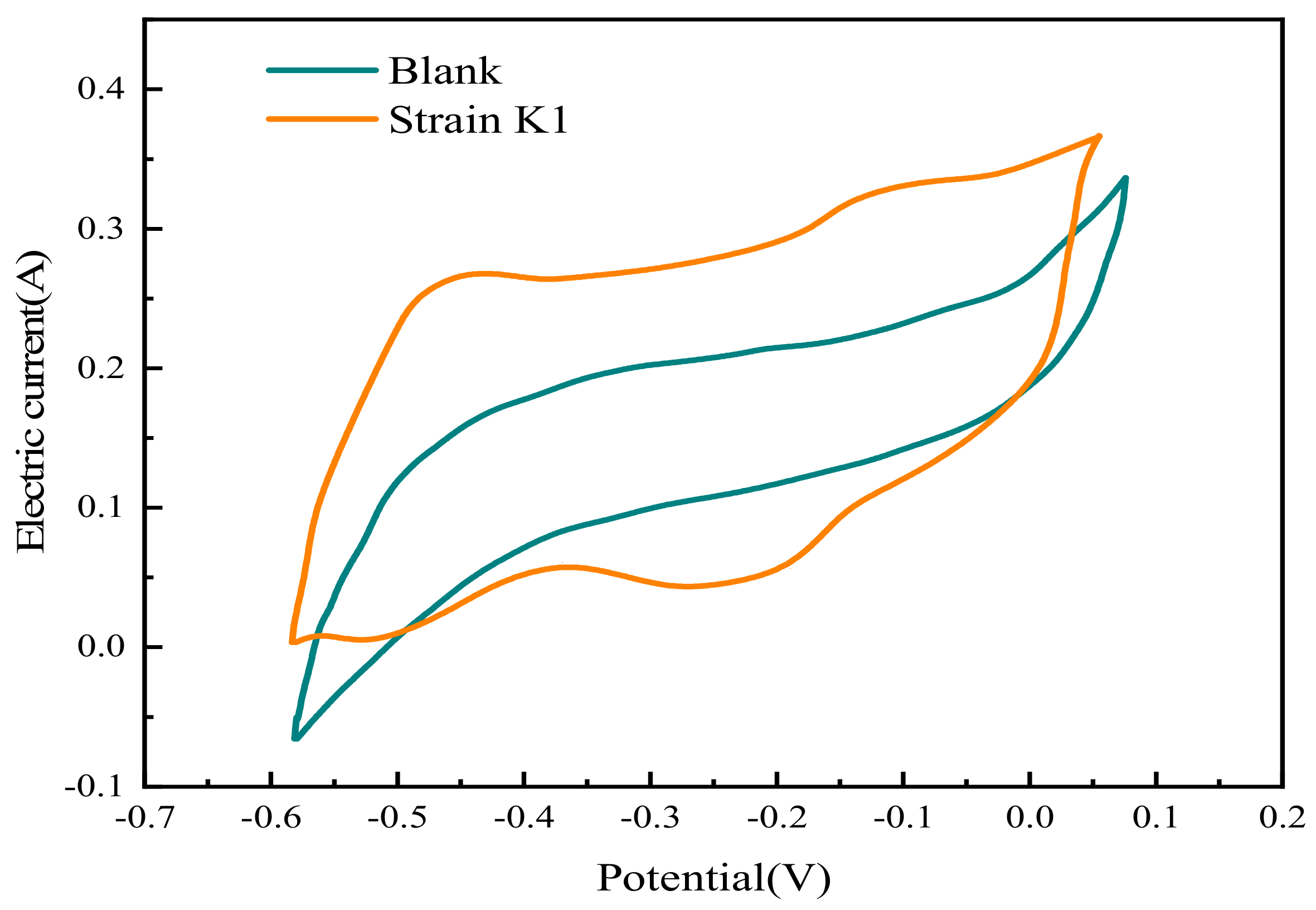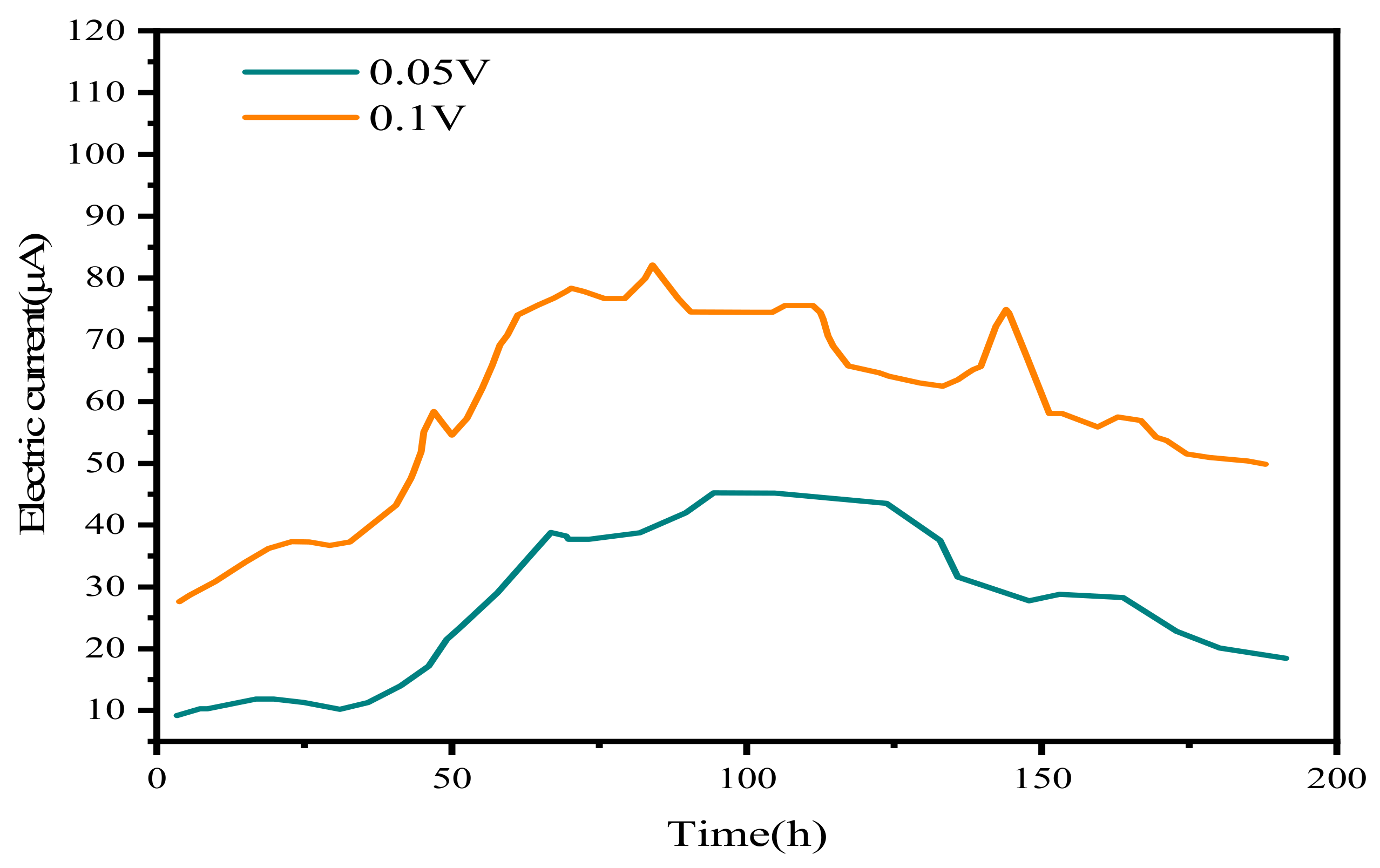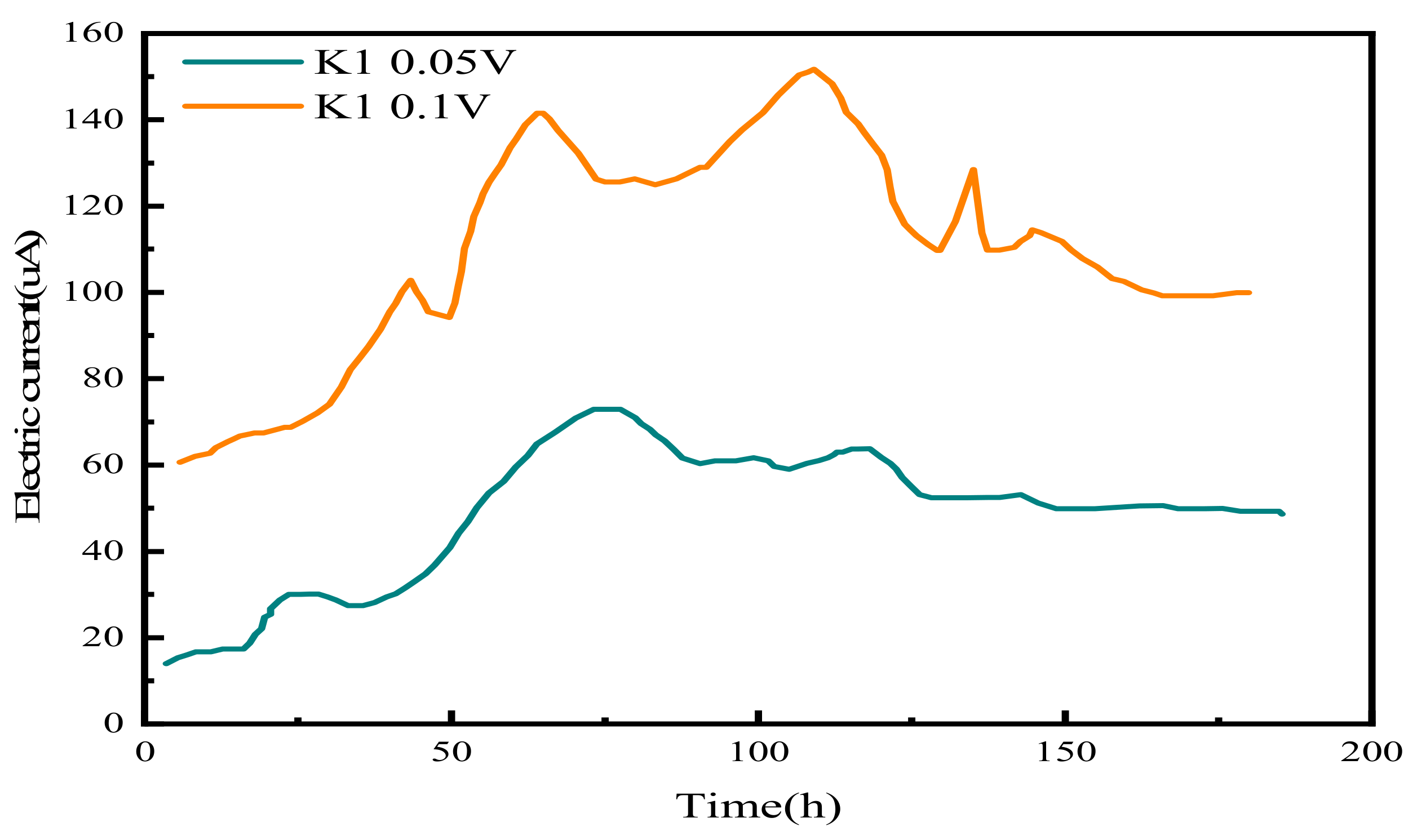Effect of Electro-Oil Acclimation of an Indigenous Strain on the Performance of Sediment Microbial Fuel Cells (SMFC)
Abstract
1. Introduction
2. Experimental
2.1. Materials
2.1.1. Chemical Materials
2.1.2. Other Materials
2.2. Experimental Methods
2.2.1. Isolation and Identification of Indigenous Bacteria
2.2.2. Electric-Oil-Induced Domestication
2.2.3. Construction of SMFC
2.2.4. SMFC Electricity Generation and Oil Removal Test
2.2.5. Gas Chromatography-Mass Spectrometry n-Alkanes Component Test
2.2.6. Cyclic Voltammetry and Chronoamperometry Test
3. Results and Discussion
3.1. Strain Identification
3.2. Electric-Oil-Induced Domestication
3.3. Analysis of the Effect of Strain K1 on SMFC
3.4. Electrochemical Activity Analysis
4. Conclusions
Author Contributions
Funding
Data Availability Statement
Conflicts of Interest
References
- Ge, C.; Lei, D.; Liu, S.; Shen, Y.; Liu, Z.; Shan, H. Pilot Studies on Treatment of Oily Solid Waste with Ex Situ Smoldering Remediation Technology. Chin. J. Environ. Eng. 2022, 16, 601–611. [Google Scholar] [CrossRef]
- Liu, F.; Liu, H.; Zhu, H.; Xie, Y.; Zhang, D.; Cheng, Y.; Zhang, J.; Feng, R.; Yang, S. Remediation of petroleum hydrocarbon contaminated groundwater by biochar immobilized bacterial consortia. Environ. Chem. 2022, 41, 3436–3447. [Google Scholar] [CrossRef]
- Pinedo, J.; Ibáñez, R.; Lijzen, J.P.A.; Irabien, A. Assessment of soil pollution based on total petroleum hydrocarbons and individual oil substances. J. Environ. Manag. 2013, 130, 72–79. [Google Scholar] [CrossRef] [PubMed]
- Yang, Y.; Ding, Y.; Hu, Y.; Cao, B.; Rice, S.A.; Kjelleberg, S.; Song, H. Enhancing bidirectional electron transfer of Shewanella oneidensis by a synthetic flavin pathway. ACS Synth. Biol. 2015, 4, 815–823. [Google Scholar] [CrossRef]
- Song, X.; Wang, W.; Cao, X.; Wang, Y.; Zou, L.; Ge, X.; Zhao, Y.; Si, Z.; Wang, Y. Chlorella vulgaris on the cathode promoted the performance of sediment microbial fuel cells for electrogenesis and pollutant removal. Sci. Total Environ. 2020, 728, 138011. [Google Scholar] [CrossRef]
- Xia, C.; Xu, M.; Liu, J.; Guo, J.; Yang, Y. Sediment microbial fuel cell prefers to degrade organic chemicals with higher polarity. Bioresour. Technol. 2015, 190, 420–423. [Google Scholar] [CrossRef]
- Wang, A.; Cheng, H.; Ren, N.; Cui, D.; Lin, N.; Wu, W. Sediment microbial fuel cell with floating biocathode for organic removal and energy recovery. Front. Environ. Sci. Eng. 2012, 6, 569–574. [Google Scholar] [CrossRef]
- Song, T.; Tan, W.; Wu, X.; Zhou, C.C. Effect of graphite felt and activated carbon fiber felt on performance of freshwater sediment microbial fuel cell. J. Chem. Technol. Biotechnol. 2012, 87, 1436–1440. [Google Scholar] [CrossRef]
- Xu, X.; Zhao, Q.; Wu, M.; Ding, J.; Zhang, W. Biodegradation of organic matter and anodic microbial communities analysis in sediment microbial fuel cells with/without Fe (III) oxide addition. Bioresour. Technol. 2017, 225, 402–408. [Google Scholar] [CrossRef]
- Guo, H.; Xie, S.; Deng, H.; Geng, X.; Wang, P.; Huang, C.; Tang, S. Electricity production and bacterial communities of microbial fuel cell supplied with oily sludge. Environ. Prog. Sustain. Energy 2020, 39, e13409. [Google Scholar] [CrossRef]
- Cai, T.; Zhang, Y.; Wang, N.; Zhang, Z.; Lu, X.; Zhen, G. Electrochemically active microorganisms sense charge transfer resistance for regulating biofilm electroactivity spatio-temporal distribution, and catabolic pathway. Chem. Eng. J. 2022, 442, 136248. [Google Scholar] [CrossRef]
- Rui, Z.; Yun, W.; Lutian, W.; Qiang, W.; Hongwei, Z. Cathode Denitrification of Microbial Fuel Cells. Prog. Chem. 2020, 32, 2013–2021. [Google Scholar] [CrossRef]
- Yuan, Y.; Li, J.; Zhang, Z.; Song, B.; Liu, F.; Zhang, J. Effect of carbon cloth-loaded Co3O4 nanosheet array anode on the power generation performance of microbial fuel cell. Chin. J. Environ. Eng. 2022, 16, 2447–2456. [Google Scholar] [CrossRef]
- Qian, Z.; Yang, L.; Xie, B.; Liu, H.; Liu, H. Isolation and identification of a simultaneous electricity production and denitrification strain in a microbial fuel cell with biocathode and its characteristics. Chin. J. Environ. Eng. 2019, 13, 1986–1994. [Google Scholar] [CrossRef]
- You, Z.; Li, F.; Hao, S. Design and construction of electroactive cells by synthetic biology strategies. Synth. Biol. J. 2022, 3, 1031. [Google Scholar] [CrossRef]
- Lin, T.; Ding, W.; Sun, L.; Wang, L.; Liu, C.-G.; Song, H. Engineered Shewanella oneidensis-reduced graphene oxide biohybrid with enhanced biosynthesis and transport of flavins enabled a highest bioelectricity output in microbial fuel cells. Nano Energy 2018, 50, 639–648. [Google Scholar] [CrossRef]
- Yang, Y.; Xu, M.; Guo, J.; Sun, G. Bacterial extracellular electron transfer in bioelectrochemical systems. Process Biochem. 2012, 47, 1707–1714. [Google Scholar] [CrossRef]
- Liu, L.; Xiao, Y.; Wu, Y.; Chen, B.; Zhao, F. Electron transfer mediators in microbial electrochemical systems. Prog. Chem. 2014, 26, 1859. [Google Scholar] [CrossRef]
- Shao, Y.-Z.; Che, J.; Cheng, C.; Jiang, Z.-Y.; Xue, C. Advances in Molecular Biological Methods to Improve Extracellular Electron Transport Efficiency of Electroactive Microorganisms. China Biotechnol. 2021, 41, 50–59. [Google Scholar] [CrossRef]
- Huang, Y.; He, Z.; Xu, L.; Yang, B.; Hou, Y.; Lei, L.; Li, Z. Alternating current enhanced bioremediation of petroleum hydrocarbon-contaminated soils. Environ. Sci. Pollut. Res. 2021, 28, 47562–47573. [Google Scholar] [CrossRef]
- Zhang, Z.; Zhong, W.; Mu, H. Refinery residual sludge reduction technologies by using multi-function microbe. J. Petrochem. Univ. 2010, 23, 23. [Google Scholar]
- Cerqueira, V.S.; Hollenbach, E.B.; Maboni, F.; Vainstein, M.H.; Camargo, F.A.O.; Maria do Carmo, R.P.; Bento, F.M. Biodegradation potential of oily sludge by pure and mixed bacterial cultures. Bioresour. Technol. 2011, 102, 11003–11010. [Google Scholar] [CrossRef] [PubMed]
- Da Silva, L.J.A.; Alves, F.C.; de França, F.P. A review of the technological solutions for the treatment of oily sludges from petroleum refineries. Waste Manag. Res. 2012, 30, 1016–1030. [Google Scholar] [CrossRef] [PubMed]
- ElMekawy, A.; Hegab, H.M.; Dominguez-Benetton, X.; Pant, D. Internal resistance of microfluidic microbial fuel cell: Challenges and potential opportunities. Bioresour. Technol. 2013, 142, 672–682. [Google Scholar] [CrossRef] [PubMed]
- Ma, D.; Jiang, Z.-H.; Lay, C.-H.; Zhou, D. Electricity generation from swine wastewater in microbial fuel cell: Hydraulic reaction time effect. Int. J. Hydrog. Energy 2016, 41, 21820–21826. [Google Scholar] [CrossRef]
- Hirose, A.; Kouzuma, A.; Watanabe, K. Towards development of electrogenetics using electrochemically active bacteria. Biotechnol. Adv. 2019, 37, 107351. [Google Scholar] [CrossRef]
- Modestra, J.A.; Mohan, S.V. Bio-electrocatalyzed electron efflux in Gram positive and Gram negative bacteria: An insight into disparity in electron transfer kinetics. RSC Adv. 2014, 4, 34045–34055. [Google Scholar] [CrossRef]
- Yu, Y.; Wu, Y.; Cao, B.; Gao, Y.-G.; Yan, X. Adjustable bidirectional extracellular electron transfer between Comamonas testosteroni biofilms and electrode via distinct electron mediators. Electrochem. Commun. 2015, 59, 43–47. [Google Scholar] [CrossRef]
- Chen, L.; Xiao, C.; Luo, X.; Sun, W. Study on biological degradation and transform characteristics of different components in petroleum hydrocarbon used by bacterial consortium. Environ. Earth Sci. 2016, 75, 816. [Google Scholar] [CrossRef]
- Hobday, A.J.; Smith, A.D.M.; Stobutzki, I.C.; Bulman, C.; Daley, R.; Dambacher, J.M.; Deng, R.A.; Dowdney, J.; Fuller, M.; Furlani, D.; et al. Ecological risk assessment for the effects of fishing. Fish. Res. 2011, 108, 372–384. [Google Scholar] [CrossRef]
- Velho-Pereira, S.; Kamat, N. Antimicrobial screening of actinobacteria using a modified cross-streak method. Indian J. Pharm. Sci. 2011, 73, 223. [Google Scholar] [CrossRef]
- Wolcott, R.D.; Hanson, J.D.; Rees, E.J.; Koenig, C.D.; Wolcott, R.A.; Cox, S.B.; White, J.S. Analysis of the chronic wound microbiota of 2,963 patients by 16S rDNA pyrosequencing. Wound Repair Regen. 2016, 24, 163–174. [Google Scholar] [CrossRef]
- Narisetty, V.; Prabhu, A.A.; Bommareddy, R.R.; Cox, R.; Agrawal, D.; Misra, A.; Haider, M.A.; Bhatnagar, A.; Pandey, A.; Kumar, V. Development of Hypertolerant Strain of Yarrowia lipolytica Accumulating Succinic Acid Using High Levels of Acetate. ACS Sustain. Chem. Eng. 2022, 10, 10858–10869. [Google Scholar] [CrossRef]
- Carmona-Martinez, A.A.; Harnisch, F.; Fitzgerald, L.A.; Schröder, U. Cyclic voltammetric analysis of the electron transfer of Shewanella oneidensis MR-1 and nanofilament and cytochrome knock-out mutants. Bioelectrochemistry 2011, 81, 74–80. [Google Scholar] [CrossRef]
- Lemos, J.G.; Stefanello, A.; Garcia, M.V.; Furian, A.F.; Cichoski, A.J.; Copetti, M.V. Potential of electrolyzed water to inactivate bread and cheese spoilage fungi. Food Res. Int. 2022, 162, 111931. [Google Scholar] [CrossRef]
- Light, S.H.; Su, L.; Rivera-Lugo, R.; Cornejo, J.A.; Louie, A.; Iavarone, A.T.; Ajo-Franklin, C.M.; Portnoy, D.A. A flavin-based extracellular electron transfer mechanism in diverse Gram-positive bacteria. Nature 2018, 562, 140–144. [Google Scholar] [CrossRef]
- Kokko, M.E.; Mäkinen, A.E.; Sulonen, M.L.K.; Puhakka, J.A. Effects of anode potentials on bioelectrogenic conversion of xylose and microbial community compositions. Biochem. Eng. J. 2015, 101, 248–252. [Google Scholar] [CrossRef]
- Kang, M.; Ren, L.; Ren, H.; Zhao, Y.; Kawamura, K.; Zhang, H.; Wei, L.; Sun, Y.; Wang, Z.; Fu, P. Primary biogenic and anthropogenic sources of organic aerosols in Beijing, China: Insights from saccharides and n-alkanes. Environ. Pollut. 2018, 243 Pt B, 1579–1587. [Google Scholar] [CrossRef]
- Fan, J.; Okyay, T.O.; Rodrigues, D.F. The synergism of temperature, pH and growth phases on heavy metal biosorption by two environmental isolates. J. Hazard. Mater. 2014, 279, 236–243. [Google Scholar] [CrossRef]
- Zhai, Q.; Gong, S.; Wang, Y.; Lyu, Q.; Liu, Y.; Ling, Y.; Wang, J.; Simon, G.P.; Cheng, W. Enokitake mushroom-like standing gold nanowires toward wearable noninvasive bimodal glucose and strain sensing. ACS Appl. Mater. Interfaces 2019, 11, 9724–9729. [Google Scholar] [CrossRef]
- Wang, W.; He, Y.; Wang, B.; Dong, M.; Zhang, H.; Shen, C. Experimental study on wax removal and viscosity reduction of waxy crude oil by Ochrobactrum intermedium. J. Pet. Sci. Eng. 2022, 213, 110445. [Google Scholar] [CrossRef]
- Cai, L.; Zhang, H.; Feng, Y.; Dong, B.; Wang, Y.; Ge, C. Iron and carbon granules added to anode enhanced the sludge decrement and electrical performance of sludge microbial fuel cell. Chem. Eng. J. 2019, 372, 572–580. [Google Scholar] [CrossRef]
- Zhao, J.; Wang, L.; Tang, L.; Ren, R.; You, W.; Farooq, R.; Wang, Z.; Zhang, Y. Changes in bacterial community structure and humic acid composition in response to enhanced extracellular electron transfer process in coastal sediment. Arch. Microbiol. 2019, 201, 897–906. [Google Scholar] [CrossRef] [PubMed]
- Chen, C.Y.; Chen, T.Y.; Chung, Y.C. A comparison of bioelectricity in microbial fuel cells with aerobic and anaerobic anodes. Environ. Technol. 2014, 35, 286–293. [Google Scholar] [CrossRef]
- Wu, M.S.; Xu, X.; Zhao, Q.; Wang, Z.Y. Simultaneous removal of heavy metals and biodegradation of organic matter with sediment microbial fuel cells. RSC Adv. 2017, 7, 53433–53438. [Google Scholar] [CrossRef]
- Wingfors, H.; Hägglund, L.; Magnusson, R. Characterization of the size-distribution of aerosols and particle-bound content of oxygenated PAHs, PAHs, and n-alkanes in urban environments in Afghanistan. Atmos. Environ. 2011, 45, 4360–4369. [Google Scholar] [CrossRef]














| Parameter | Main Peak Carbon Number | OEP | W∑(C21−)/W∑(C22+) | W(Pr)/W(W17) | W(Ph)/W(C18) | |||||
|---|---|---|---|---|---|---|---|---|---|---|
| Before | After | Before | After | Before | After | Before | After | Before | After | |
| Group 1 | 26 | 24 | 1.38 | 1.37 | 0.72 | 0.79 | 1.79 | 1.96 | 0.78 | 0.82 |
| Group 2 | 26 | 19 | 1.38 | 1.68 | 0.72 | 0.95 | 1.79 | 2.25 | 0.78 | 0.85 |
Disclaimer/Publisher’s Note: The statements, opinions and data contained in all publications are solely those of the individual author(s) and contributor(s) and not of MDPI and/or the editor(s). MDPI and/or the editor(s) disclaim responsibility for any injury to people or property resulting from any ideas, methods, instructions or products referred to in the content. |
© 2023 by the authors. Licensee MDPI, Basel, Switzerland. This article is an open access article distributed under the terms and conditions of the Creative Commons Attribution (CC BY) license (https://creativecommons.org/licenses/by/4.0/).
Share and Cite
Pan, Y.; Tang, S.; Ren, W.; Cheng, Y.; Gao, J.; Huang, C.; Fu, K. Effect of Electro-Oil Acclimation of an Indigenous Strain on the Performance of Sediment Microbial Fuel Cells (SMFC). Energies 2023, 16, 5582. https://doi.org/10.3390/en16145582
Pan Y, Tang S, Ren W, Cheng Y, Gao J, Huang C, Fu K. Effect of Electro-Oil Acclimation of an Indigenous Strain on the Performance of Sediment Microbial Fuel Cells (SMFC). Energies. 2023; 16(14):5582. https://doi.org/10.3390/en16145582
Chicago/Turabian StylePan, Yao, Shanfa Tang, Wen Ren, Yuanpeng Cheng, Jie Gao, Chunfeng Huang, and Ke Fu. 2023. "Effect of Electro-Oil Acclimation of an Indigenous Strain on the Performance of Sediment Microbial Fuel Cells (SMFC)" Energies 16, no. 14: 5582. https://doi.org/10.3390/en16145582
APA StylePan, Y., Tang, S., Ren, W., Cheng, Y., Gao, J., Huang, C., & Fu, K. (2023). Effect of Electro-Oil Acclimation of an Indigenous Strain on the Performance of Sediment Microbial Fuel Cells (SMFC). Energies, 16(14), 5582. https://doi.org/10.3390/en16145582





